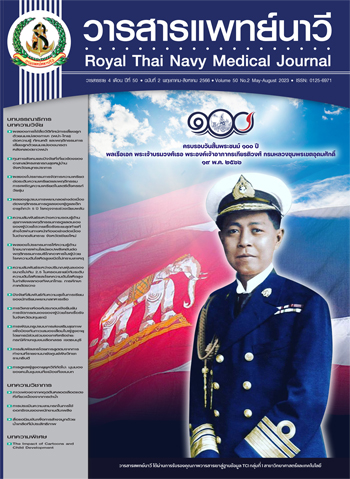Occupational Inhalation Exposures Reported to Ramathibodi Poison Center
Main Article Content
Abstract
This is a retrospective descriptive study of occupational inhalation exposures reported to Ramathibodi Poison Center during 2017 - 2021. The main objective was to describe the number of patients, characteristic of patients, substances, exposure characteristics, and outcome of occupational inhalation exposures reported to Ramathibodi Poison Center.
There were 662 cases which included agricultural work (39.7%), factory work (27.9%), other types of work (23.7%), and unspecified work (8.6%). Common scenario included exposure during spraying (25.5%), exposure during mixing (14.2%), gas leaking incidence (12.9%), and working in confined space (9.2%). It was reported that 72.8% were not wearing appropriate personal protective equipment (PPE). Commonly reported substances were chlorine, sodium hypochlorite, ammonia, paraquat, carbamate, and hydrogen sulfide.
Training on the safe use of chemicals and equipment related to chemicals should be provided. It is also important to organize an encouraging campaign and monitor appropriate PPE use for workers.
Article Details

This work is licensed under a Creative Commons Attribution-NonCommercial-NoDerivatives 4.0 International License.
References
Saeed O, Boyer NL, Pamplin JC, Driscoll IR, DellaVolpe J, Cannon J, et al. Inhalation injury and toxic industrial chemical exposure. Mil Med 2018;183 (Suppl 2):130-2.
Tanizaki S. Assessing inhalation injury in the emergency room. Open Access Emerg Med 2015;7:31-7.
Miller K, Chang A. Acute inhalation injury. Emerg Med Clin North Am 2003;21(2):533-57.
Gill P. Martin RV. Smoke inhalation injury. BJA Education 2015;15(3): 143-8.
Wijnands APG, de Vries I, Verbruggen T, Carlier MP, de Lange DW, Rietjens SJ. Acute occupational exposures reported to the Dutch Poisons Information Center: a prospective study on the root causes of incidents at the workplace. J Occup Med Toxicol 2022;17(19):19.
Downs JW, Wills BK, Cumpston KL, Rose SR. Descriptive epidemiology of clinically significant occupational poisonings, United States, 2008-2018. Clin Toxicol (Phila) 2021;59(2):1259-63.
Industrial Safety Technology Promotion Division. Accidental incidence 2021. [Internet]. [cited 2023 March 1]. Available from: http://reg3.diw.go.th/safety/อุบัติเหตุ/ข้อมูลสถิติอุบัติเหตุ-7/. (in Thai).
M Report. Lesson learned from “Mingdi Chemical” to set factory fire prevention measures. [Internet]. [cited 2023 March 1]. Available from: https://www.mreport.co.th/news/governmentnews/326-Mingdi-Chemical-to-set-Factory-Fire-Prevention-Measures. (in Thai).
Thairath Online. Chemical spill from oil boiler at Nakhon Pathom, confirmed no carcinogen. [Internet]. [cited 2023 March 1]. Available from:https://www.thairath.co.th/news/local/central/2509002. (in Thai).
Thailand Institute of Occupational Safety and Health. Death and hazard prevention for working in confined space. [Internet]. [cited 2023 March 2]. Available from: https://www.tosh.or.th/index.php/blog/item/473-2019-02-06-07-31-58. (in Thai).
Matichon Online. Department of disease control investigated unconscious and dead workers in water pipe; there are 12 deaths in 2021. [Internet]. [cited 2023 March 1]. Available from: https://www.matichon.co.th/local/quality-life/news_3463963. (in Thai).
Ramathibodi Poison Center. Ramathibodi Poison Center Statistics, 2021. [internet]. [cited 2023 April 15]. Available from: https://www.rama.mahidol.ac.th/poisoncenter/sites/default/files/public/pdf/2021.1.pdf.
American Association of Poison Control Centers. National Poison Data System (NPDS): NPDS Coding Users’ Manual. Version 3.;2014.
Chalamwong Y. New wave of COVID-19 impact on Thai labor market. Thailand Development Research Institute [Internet]. [cited 2023 April 15]. Available from:https://tdri.or.th/2021/01/covid-19-impact-on-migrant-workers-2/
Raffee L, Daradkeh HM, Alawneh K, Al-Fwadleh AI, Darweesh M, Hammad NH, et al. Impact of COVID-19 lockdown on the incidence and patterns of toxic exposures and poisoning in Jordan: a retrospective descriptive study. BMJ Open 2021;11(12):e053028.
Henneberger PK, Metayer C, Layne LA, Althouse R. Nonfatal work-related inhalations: surveillance data from hospital emergency departments, 1995–1996. Am J Ind Med 2000;38(2):140-8.
Valent F, McGwin G Jr, Bovenzi M, Barbone F. Fatal work-related inhalation of harmful substances in the United States. Chest 2002;121(3):969-75.
Open Government Data of Thailand. Rate of employment of working age population. [internet]. [cited 2023 April 15]. Available from: https://data.go.th/dataset/os_02_00016. (in Thai).
Tongpoo A, Sriapha C, Wongvisawakorn S, Rittilert P, Trakulsrichai S, Wananukul W. Occupational carbamate poisoning in Thailand. Southeast Asian J Trop Med Public Health 2015;46(4):798-804.
Plianbangchang P, Jetiyanon K, Wittaya-Areekul S. Pesticide use patterns among small-scale farmers: a case study from Phitsanulok, Thailand. Southeast Asian J Trop Med Public Health. 2009;40(2):401-10.
Choeisuwan V, Chuenwisit A, Na Bangchang A, Kerdmanee C, Potisa S. A study of health status and health protective behaviors among fishermen in Samutsakorn Province. Royal Thai Navy Medical Journal 2014;41(3):1-22.
Deesua A, Keawpan W, Kalampakorn S, Sillabutra J. Factors associated with preventive behaviors of work related COVID-19 among aging taxi drivers in Bangkok. Royal Thai Navy Medical Journal. 2022;49(2):369-84
Canadian Centre for Occupational Health and Safety. Confined space. [internet]. [cited 2023 March 5]. Available from: https://www.ccohs.ca/oshanswers/hsprograms/confinedspace/confinedspace_intro.html.

